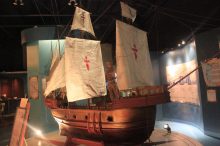Asian Institute of Maritime Studies (AIMS) - Museo Maritimo, the Philippines
 The archipelagic nature of the Philippines, its strategic location as a crossroads in the maritime trade routes, and the large contribution of Filipino seafarers in the global seafaring industry necessitates a maritime theme museum which will serve as a repository of maritime knowledge and history. Museo Maritimo is dedicated to the Filipino seafarers and pays homage to their contribution to nation-building from the distant past to the present. On 23 March 2012, Museo Maritimo had its grand launch at the Philippine Trade and Training Center, the first maritime-themed museum in the country, that showcases its long and rich maritime history and how it has developed through centuries.
Museo Maritimo is a project envisioned and initiated by the Asian Institute of Maritime Studies (AIMS), under the keen supervision and efforts of its President, Mrs. Arlene Abuid-Paderanga, Ed. D., in collaboration with Hiniraya Cultural and Heritage Foundation and its partner organisation ICOM Philippines. Museo Maritimo utilises imaginative exhibitions and displays to illustrate what the Philippine seafaring, training and manning history is and who its leaders are. Furthermore, it serves as a repository for valuable collections of marine art, ship model
The archipelagic nature of the Philippines, its strategic location as a crossroads in the maritime trade routes, and the large contribution of Filipino seafarers in the global seafaring industry necessitates a maritime theme museum which will serve as a repository of maritime knowledge and history. Museo Maritimo is dedicated to the Filipino seafarers and pays homage to their contribution to nation-building from the distant past to the present. On 23 March 2012, Museo Maritimo had its grand launch at the Philippine Trade and Training Center, the first maritime-themed museum in the country, that showcases its long and rich maritime history and how it has developed through centuries.
Museo Maritimo is a project envisioned and initiated by the Asian Institute of Maritime Studies (AIMS), under the keen supervision and efforts of its President, Mrs. Arlene Abuid-Paderanga, Ed. D., in collaboration with Hiniraya Cultural and Heritage Foundation and its partner organisation ICOM Philippines. Museo Maritimo utilises imaginative exhibitions and displays to illustrate what the Philippine seafaring, training and manning history is and who its leaders are. Furthermore, it serves as a repository for valuable collections of marine art, ship model s, and nautical artifacts.
Museo Maritimo believes that museums are not only storehouses of history and knowledge, but should also serve as factories of knowledge. In realising this objective, the museum promotes not only heritage awareness, but also takes part in nation-building and knowledge generation by conducting quality research, conferences, seminars, and lectures that will make everyone conscious about maritime past, present, and future.
Permanent collections: The museum is divided into six sections, as follows:
s, and nautical artifacts.
Museo Maritimo believes that museums are not only storehouses of history and knowledge, but should also serve as factories of knowledge. In realising this objective, the museum promotes not only heritage awareness, but also takes part in nation-building and knowledge generation by conducting quality research, conferences, seminars, and lectures that will make everyone conscious about maritime past, present, and future.
Permanent collections: The museum is divided into six sections, as follows:
- The first section depicts the pre-colonial maritime history of the Philippines which showcases several articles before the arrival of the Western missionaries. It exhibits replicas of prehistoric stone tools developed by pre-colonial Filipinos for dug-out boat making. It also contains miniature sizes of the ancient balangay boat. There are also displays about the early contacts of the Filipinos with the Chinese, Arabs, and Europeans.
- The second section depicts the Philippine maritime history during the Spanish Era, which features significant events that influenced the history of the Philippine Islands. This section gives importance to Manila-Acapulco Galleon Trade in which the Philippine archipelago became the main trading post between the continent of Asia and America. Apart from that, visitors can see dioramas depicting the old port of Manila.
- The third section of the museum contains interactive exhibits to entertain children, one of which is a ship simulator which allows the visitors to experience ship operations.
- The fourth section is dedicated to the anchors of the Philippine Maritime Industry in the contemporary period, in which the museum pays homage to their great contributions in the advancement of the industry in the country.
- The fifth section will give visitors a glimpse about the history of the Philippine Navy and Coast Guard and a short history of customs administration.
- The final or sixth section of the museum displays the timeline and history of the Asian Institute of Maritime Studies (AIMS) and the contribution of Captain Willijado P. Abuid of the Philippine Navy, who established the institution with the goal of becoming the ome of maritime knowledge exchange in the Philippines.
View all Asia-Europe Museum Network (ASEMUS) members in the Philippines
Similar content
10 Oct 2019 - 11 Oct 2019
posted on
08 Sep 2010
04 Dec 2014
posted on
30 Nov 2011
posted on
14 Mar 2012

